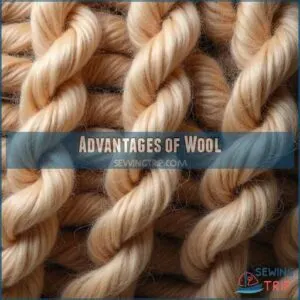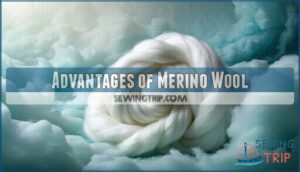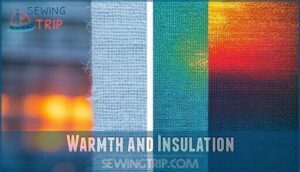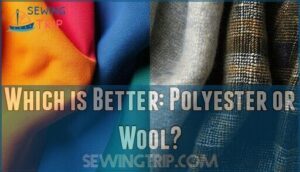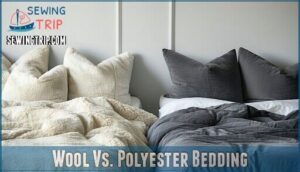This site is supported by our readers. We may earn a commission, at no cost to you, if you purchase through links.
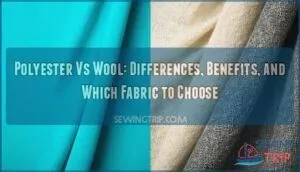 When comparing polyester vs wool, you’re choosing between very different fabric worlds.
When comparing polyester vs wool, you’re choosing between very different fabric worlds.
Polyester offers durability and affordability—it’s your reliable friend that won’t shrink or wrinkle easily.
Wool provides natural insulation that keeps you warm even when wet, like having a built-in thermostat.
You’ll find polyester easier to care for with machine washing, while wool requires gentler handling.
Performance-wise, wool wicks moisture better and doesn’t trap odors like polyester can after a long hike.
Your decision ultimately depends on your specific needs—budget, maintenance time, and intended use all matter when selecting between these fabric contenders.
Table Of Contents
- Key Takeaways
- Understanding Polyester and Wool
- Advantages of Polyester
- Advantages of Wool
- Advantages of Merino Wool
- Characteristics of Polyester and Wool
- Washing Polyester and Wool
- When to Use Polyester or Wool
- Which is Better: Polyester or Wool?
- Wool Vs. Polyester Bedding
- Max DesMarais and Hiking & Fishing
- Frequently Asked Questions (FAQs)
- Conclusion
Key Takeaways
- Polyester offers you durability and affordability with machine-washable care, but it lacks breathability and can trap odors after extended wear.
- Wool provides you with natural temperature regulation that works in all seasons, superior moisture-wicking abilities even when wet, and natural odor resistance for longer wear.
- You’ll find wool is more environmentally friendly as it’s biodegradable within 3-4 months, while polyester is petroleum-based and can remain in the environment for centuries.
- Your activity and climate should determine your choice—polyester works best for high-intensity workouts and wet conditions, while wool excels in variable temperatures and moderate activities.
Understanding Polyester and Wool
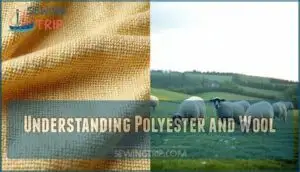
Polyester and wool emerge from distinct origins, offering unique material properties.
Polyester, a synthetic fiber, is crafted from petroleum-based chemicals, while wool, a natural fiber, comes from sheep’s fleece.
Wool’s structure traps air, regulating body temperature across seasons.
Meanwhile, polyester shines in durability and affordability, but lacks wool’s breathability.
Wool’s environmental benefits outshine polyester, as its production avoids microplastic pollution.
Both fibers have their place—polyester is globally available and low-maintenance, whereas wool delivers unmatched comfort and ecological consideration in fabric comparison.
The weave structure impacts a fabric’s drape and breathability.
Advantages of Polyester
You’ve likely seen polyester praised for its cost-effectiveness, but that’s just the beginning.
This durable, lightweight fabric resists stains and wrinkles, making it a low-maintenance favorite.
Its water-resistant nature suits wet weather perfectly, and its vibrant dyeability adds stylish possibilities.
Key polyester advantages include:
- Versatile applications: Ideal for clothing, bedding, and furniture.
- Lightweight feel: Won’t weigh you down, even in hot climates.
- Durability: Strong, elastic fibers handle wear and tear impressively.
For affordable, practical fabric, polyester delivers consistently.
Advantages of Wool
When considering wool, you’re getting a luxury fiber that delivers unmatched benefits.
Its natural breathability and superior warmth keep you cozy, while its odor resistance guarantees freshness during long wears.
Wool fabric is also biodegradable, making it eco-friendly, unlike synthetics.
Wool also provides superior insulation when wet, a key advantage over other materials like fleece.
With wool durability and timeless appeal, it’s perfect for everything from outdoor gear to elegant suits.
Though wool cost can be higher, its sustainability and renewability make it worth considering.
Choose wool for comfort, functionality, and environmental responsibility.
Advantages of Merino Wool
Merino wool, a standout among natural fibers, delivers superior softness, making it ideal for sensitive skin.
Its natural crimp creates air pockets, supporting temperature regulation and enhanced drape in both warm and cold weather.
With built-in odor resistance and moisture management, Merino outshines synthetic fabrics like polyester.
Plus, it’s eco-friendly, renewable, and fire retardant—a win for safety and sustainability.
As a finer alternative to standard wool, it’s known for its superior moisture-wicking capabilities.
- Breathability: Keeps you cool or warm naturally.
- Odor Resistance: Absorbs moisture, minimizing smells.
- Sustainability: Renewable, reducing environmental harm.
- Durability: Soft yet resilient for long-term use.
Characteristics of Polyester and Wool
When comparing polyester and wool, you’ll notice they offer distinct characteristics shaped by their origins and composition.
I’ll create a short, engaging blockquote about comparing polyester and wool that matches the tone of the article:
Nature versus science: wool’s organic warmth meets polyester’s engineered durability in the eternal fabric showdown.
Polyester’s durability and quick-drying traits contrast with wool’s breathability, warmth, and natural comfort, giving each fabric unique strengths, particularly in terms of breathability.
Warmth and Insulation
When it’s chilly, wool shines with its insulation properties, trapping air pockets that maintain fabric warmth.
Its natural ability to regulate body temperature keeps you comfortable across climates—warm in winter, cool in summer.
Polyester, while lightweight and part of effective layering systems, lacks wool’s climate adaptability and fabric breathability, often leading to overheating.
Wool’s versatility extends to its fabric thickness, adjusting to your needs, whether thin for layering or thick for insulation.
Consider wool’s insulation warmth for superior performance.
For comfort and adaptability, wool simply outperforms polyester.
Water Resistance
When comparing water resistance, these two fabrics behave quite differently.
Polyester fabric exhibits strong hydrophobic properties, repelling moisture rather than absorbing it.
This synthetic material stays lightweight when wet and offers faster drying time.
In contrast, wool fabric provides water resistance through its natural lanolin coating while maintaining wet insulation capabilities—it can absorb up to 30% of its weight in water before feeling damp.
For rainy conditions, polyester keeps you completely dry, while wool manages moisture differently, continuing to insulate even when damp.
The effectiveness of polyester is why water resistant options are readily available, making it a water resistant and fast drying option, which is also completely dry in rainy conditions.
Sustainability
Beyond water resistance, sustainability has become a critical factor in fabric selection.
When comparing eco-friendliness, wool and polyester tell two different environmental stories.
- Wool is biodegradable, breaking down in 3-4 months
- Polyester is petroleum-based and can remain in the environment for centuries
- Wool production creates carbon footprint through animal agriculture
- Recycled polyester offers a more sustainable synthetic option
- Ethical sourcing practices substantially impact environmental footprint of both materials
Cost
The price gap between polyester and wool reveals a significant contrast in your fabric investment options.
Polyester’s affordability stems from its synthetic production process, while wool commands premium prices due to its natural sourcing and processing requirements.
- Production Costs: Wool can be 10-15 times more expensive than polyester due to labor-intensive animal agriculture
- Material Sourcing: Polyester’s petroleum-based creation is cheaper and faster than wool’s seasonal harvesting
- Long-Term Value: Despite higher upfront costs, wool’s durability often provides better value over time
When comparing costs, remember that polyester offers immediate affordability, while wool represents a quality investment with extended wearability.
Comfort
While cost considerations matter, comfort plays an equally important role in your fabric decision. When comparing wool and polyester, your skin sensitivity and personal preference substantially impact your experience.
Wool and polyester offer distinct comfort profiles:
- Breathability factors: Wool naturally wicks moisture away from skin, keeping you dry during high activity levels.
- Seasonal comfort: Merino wool regulates temperature, warming you in winter and cooling you in summer.
- Softness: Natural wool fibers feel gentler against skin than polyester, which can sometimes feel synthetic.
- Odor resistance: Wool naturally repels odors, while polyester tends to retain smells after extended wear.
The right choice balances your comfort needs with your intended activities and environmental conditions.
Washing Polyester and Wool
Washing both polyester and wool requires understanding their unique care needs.
For polyester fabric, use warm water on a normal cycle with standard detergent, then tumble dry on low. Add vinegar to reduce odors. You may also need a polyester-safe detergent for best results.
Wool demands gentler treatment—wash infrequently (it’s naturally odor and stain resistant), use cold water with mild detergent on delicate cycles, and always air dry flat to prevent stretching.
For stains on wool, treat specifically: use baking soda paste for sweat marks, talcum powder for oil, and salt for wine. Machine-washable wool will indicate this on labels, but when in doubt, handwash.
When to Use Polyester or Wool
Now that you understand how to care for each material, let’s look at when to choose one over the other.
Your environment should guide your fabric selection.
For wet conditions, polyester‘s water resistance makes it ideal, while wool excels in variable temperatures due to its natural temperature regulation.
Consider your activity level too—polyester works well for high-intensity workouts, while wool shines during moderate activities in changing climates.
Budget constraints often favor polyester, though wool typically offers better long-term value.
The specific garment matters as well—polyester suits athletic wear, while wool elevates formal and cold-weather clothing.
Which is Better: Polyester or Wool?
You’ll need to keep in mind your specific needs when choosing between polyester and wool, as each fabric offers distinct performance characteristics in durability, warmth, and care requirements.
Your lifestyle and intended use will ultimately determine which material serves you better, whether you prioritize polyester’s easy maintenance and affordability or wool’s superior breathability and natural insulation properties.
Durability
When comparing fabric durability, polyester stands out as the champion in the synthetic vs. natural debate.
Its exceptional fiber strength makes it highly resistant to daily wear and tear.
- Tear resistance: Polyester fibers rarely break under tension
- Abrasion resistance: Withstands friction without deteriorating
- Pilling resistance: Maintains smooth appearance longer than wool
- Lifespan comparison: Polyester can outlast wool by years
- Material durability: Retains shape after multiple washes
While wool offers natural benefits, polyester’s remarkable durability makes it the practical choice for high-activity applications and frequent use.
Hypoallergenic Properties
When allergies strike, the fabric against your skin matters tremendously.
Wool stands as the clear hypoallergenic champion compared to polyester.
Its natural fibers are too large to trigger respiratory issues and create a microclimate that’s inhospitable to allergy triggers like dust mites and bacteria.
For those with sensitive skin, wool’s breathable structure prevents irritation factors common with synthetic fabrics.
Polyester, by contrast, attracts static electricity and allergens, while its chemical treatments and fiber structure can cause discomfort.
Merino and alpaca wool offer exceptional hypoallergenic properties for maximum comfort.
Warmth
While allergens are a consideration, warmth is where wool truly shines compared to polyester.
You’ll find wool provides superior insulation properties due to its natural fiber structure that traps body heat effectively.
For maximum climate suitability, consider these advantages:
- Wool maintains insulation even when damp
- Natural temperature regulation keeps you comfortable in varying conditions
- Wool’s air pockets provide better warmth-to-weight ratio
- Strategic layering options work better with wool’s breathability
Polyester offers decent warmth but lacks wool’s thermoregulation capabilities, and overall, wool’s natural properties make it a superior choice for insulation.
Cleaning
While warmth keeps you cozy, proper cleaning guarantees your garments last longer.
Polyester wins the convenience battle—it’s fully machine washable with standard detergents and can handle regular washing cycles without special care.
Wool requires gentler treatment. You’ll need specific wool detergents and often must handwash or dryclean to prevent shrinking.
In the context of stain removal, wool naturally repels many substances, while polyester can trap oils.
For drying methods, polyester can tumble dry on low, but wool should air dry flat to maintain shape. Ironing techniques differ too—polyester needs low heat to avoid melting, while wool requires a press cloth and medium heat.
Uses
When choosing between polyester and wool fabrics, where should each material shine in daily use? Both materials excel in different applications based on their unique properties.
Polyester fabric dominates in:
- Athletic clothing where moisture-wicking and durability are essential
- Outdoor jackets and coats requiring weather resistance and easy maintenance
- Industrial uses and blended fabrics for furniture upholstery where longevity matters.
Meanwhile, wool fabric performs best in high-quality clothing, winter accessories, and home furnishings like blankets and rugs. It’s particularly valued in niche markets seeking sustainable, natural materials.
For specialized applications, wool-polyester blends offer an excellent compromise, combining wool’s comfort with polyester’s durability.
Wool Vs. Polyester Bedding
The bedding battle between wool and polyester impacts your sleep quality more than you might realize.
The key features of each are compared in the table below:
| Feature | Wool Bedding | Polyester Bedding |
|---|---|---|
| Moisture Absorption | High (30% of weight) | Low to moderate |
| Breathability | Excellent | Limited |
| Allergen Accumulation | Naturally resistant | Can trap allergens |
| Weight | Moderate to heavy | Light to moderate |
Wool bedding regulates temperature effectively, keeping you cool in summer and warm in winter. It’s ideal for those with skin sensitivity as it wicks moisture away from your body.
Unlike wool, polyester doesn’t breathe, potentially causing discomfort. While polyester bedding costs less initially, wool’s durability and seasonal versatility make it a better long-term investment for quality sleep.
Max DesMarais and Hiking & Fishing
In partnership with Max DesMarais of DesMarais Gear, we’ve tested both polyester and wool in extreme hiking and fishing conditions.
Max’s extensive outdoor experience confirms that wool performs better for multi-day adventures due to its superior odor resistance and temperature regulation.
You’ll find that polyester excels in fishing apparel when quick-drying properties are essential, especially during water activities.
For hiking apparel, wool maintains comfort across temperature changes but costs more than synthetic alternatives.
Polyester vs wool performance depends largely on your specific activity—polyester wicks moisture effectively during high-intensity hiking but can retain odors.
Wool outdoor wear provides better insulation when wet, making it ideal for unpredictable weather conditions.
Max recommends merino wool base layers for extended trips and polyester outer layers for protection against precipitation and wind.
Frequently Asked Questions (FAQs)
Is polyester better than wool?
Like nature versus industry, the choice between wool and polyester isn’t about "better" but purpose.
Wool offers breathability and natural insulation while polyester provides durability and easy care at lower cost.
Is a polyester coat as warm as wool?
No, a polyester coat isn’t as warm as wool.
Wool naturally insulates better with its air pockets, while maintaining warmth even when damp.
You’ll notice wool’s superior temperature regulation in colder conditions.
Is a wool or polyester suit better?
Wool suits offer superior breathability, natural insulation, and professional appearance, while your polyester options cost less but sacrifice comfort. You’ll appreciate wool’s versatility across seasons despite its higher maintenance requirements.
What is the biggest disadvantage of polyester?
Nearly 70 million barrels of oil are used annually for polyester production.
Your biggest disadvantage with polyester is its environmental impact—it’s non-biodegradable, petroleum-based, and can release microplastics when washed, harming ecosystems for centuries.
How do I choose the right fabric for my outdoor clothing?
Consider your activity level, climate conditions, and comfort needs.
Choose wool for natural warmth and breathability, or polyester for durability and water resistance.
Many quality outdoor garments combine both fabrics for superior performance.
What are the environmental impacts of polyester and wool?
Over 70 million barrels of oil are used annually for polyester production.
You’ll find polyester isn’t biodegradable and releases microplastics, while wool is biodegradable but raises concerns about methane emissions from sheep farming.
Is Merino wool worth the extra cost?
Yes, Merino wool is worth the investment.
You’ll enjoy superior comfort, temperature regulation, and moisture-wicking properties.
Its softness against your skin and longer lifespan offset the higher price tag compared to synthetic alternatives.
How long does wool last compared to polyester?
Wool garments typically last 10+ years with proper care, while polyester can endure 20+ years but may pill or fade. You’ll find wool maintains its appearance better despite polyester’s technical longevity.
Are there any health benefits to wearing wool clothing?
Your body will thank you immensely for choosing wool.
It’s hypoallergenic, regulates temperature naturally, reduces skin irritation, and improves sleep quality.
Wool’s breathable fibers also minimize bacterial growth that can cause odors, which helps to keep you hypoallergenic and fresh.
Can polyester or wool cause skin allergies?
Some people experience allergies to both materials.
You’ll likely find wool causing irritation from its scratchy fibers, while polyester might trigger contact dermatitis due to the chemicals used in its production.
Conclusion
While some may worry choosing between polyester vs wool requires compromising either durability or comfort, you’ve now got the knowledge to make the right call for your specific needs.
Whether you prioritize polyester’s easy care and affordability or wool’s superior temperature regulation and natural properties, both fabrics excel in different situations.
Consider your climate, activity level, and maintenance preferences when weighing polyester vs wool—your perfect fabric choice depends entirely on your unique lifestyle requirements.
- https://www.woolx.com/blogs/woolx-journal/the-magic-of-merino-wool
- https://www.woolite.us/?gclsrc=aw.ds&&gclid=CjwKCAjwo4mIBhBsEiwAKgzXOMS7wrJRkcJ721Myh4UnfXZ1y6bD7M3OqIK3BrokTxF9M91gYkCamhoCnlgQAvD_BwE&gclsrc=aw.ds&CjwKCAjwo4mIBhBsEiwAKgzXOMS7wrJRkcJ721Myh4UnfXZ1y6bD7M3OqIK3BrokTxF9M91gYkCamhoCnlgQAvD_BwE=&j=r&ru=
- https://www.apexmills.com/media_post/what-is-polyester/
- https://knowingfabric.com/polyester-suit-vs-wool/
- https://en.wikipedia.org/wiki/Wool


